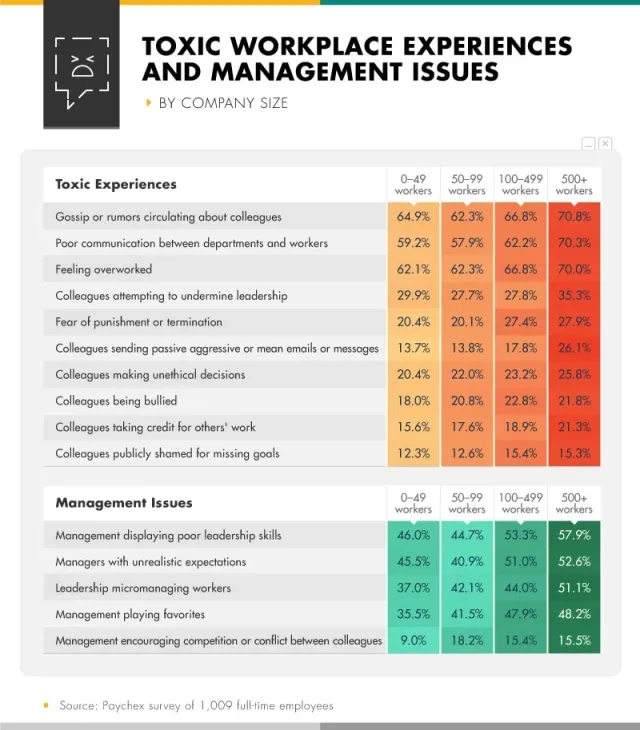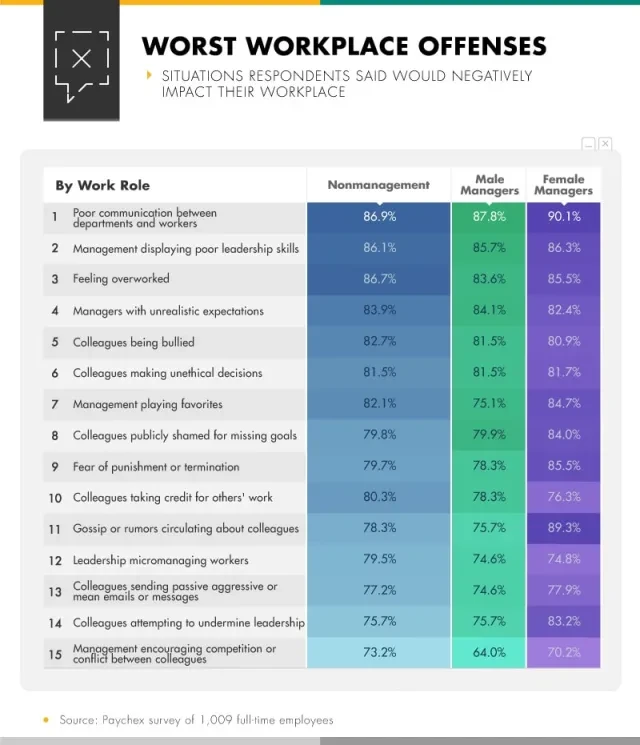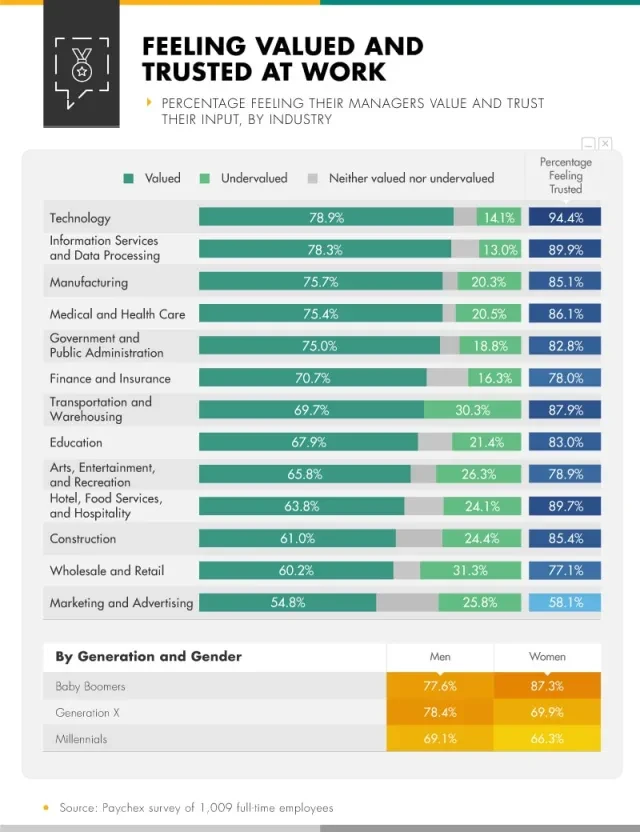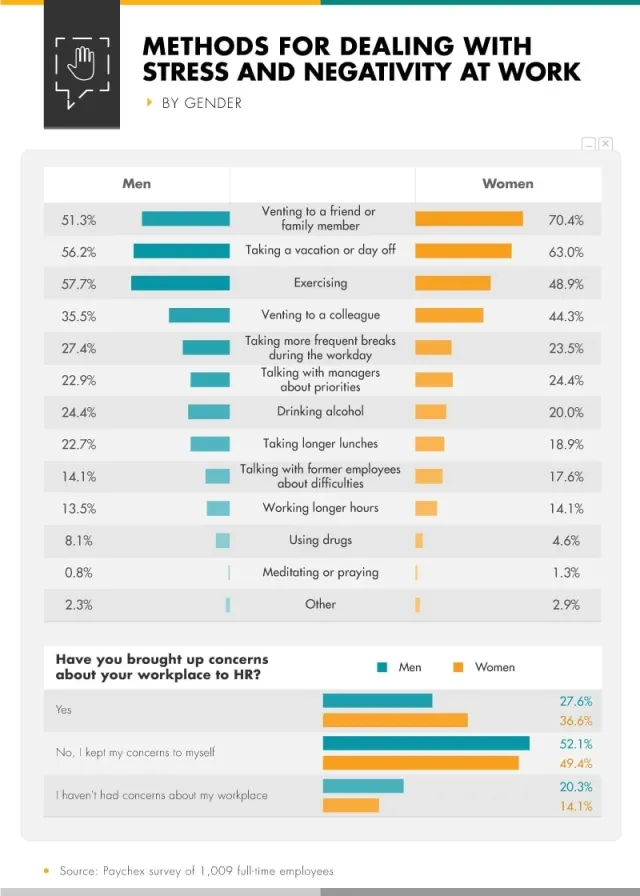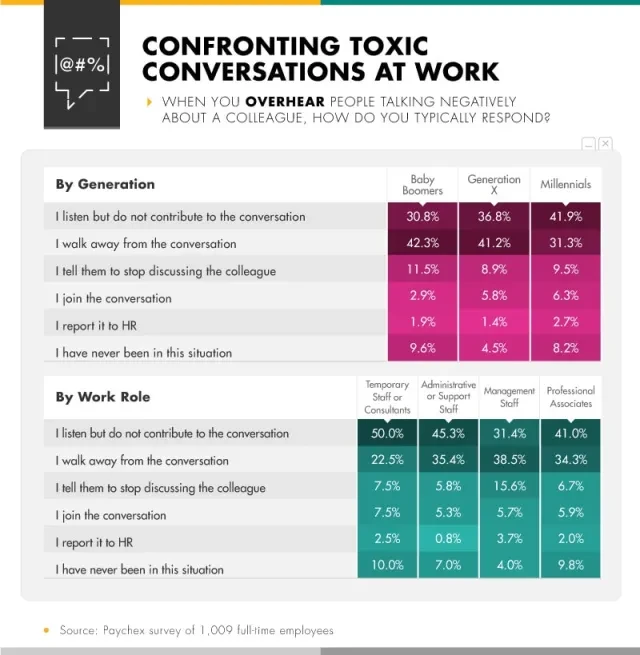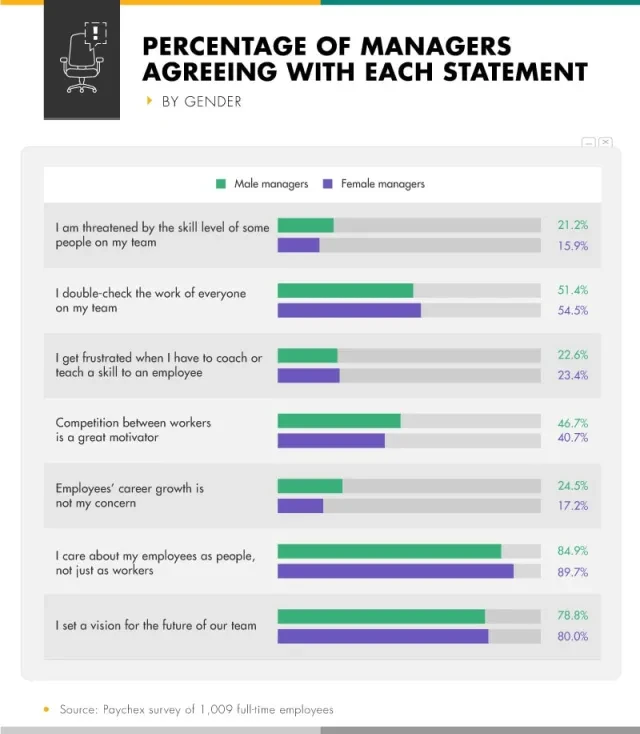Toxic Workplaces: How Workers Survive and Thrive in Unprofessional Environments
- Human Resources
- Article
-
6 min. Read
-
Last Updated: 02/19/2019

Table of Contents
In recent years, hostile work environments have attracted public attention: Oxford Dictionaries named “toxic” the word of 2018 — in part because of workplaces worthy of the adjective. Unfortunately, this discourse reflects a reality for many Americans, with nearly 1 in 5 reporting hostile or threatening work conditions. The consequences of toxic professional cultures — which can range from spreading gossip to intimidation — can be considerable, from compromised productivity to a negative impact on employee morale. But which workplace factors are simply unpleasant frustrations, and which verge into toxic territory? For an array of employees, which behaviors and conditions are most impactful?
As part of the following research, we analyzed the sentiments of over 1,000 workers, asking them which workplace factors they find most frustrating, and which offenses they observe most often. Going further, we studied how responses varied according to a range of variables, including age, sex, and position at work. Our findings present a comprehensive view of the causes of workplace hostility and suggest how businesses could improve to promote the well-being of workers. To learn what can truly make a workplace toxic, keep reading.
Prevalence of problematic behavior
In terms of workplace toxicity, size may be a liability: People at companies with 500 or more employees were the most likely to witness many kinds of negative behavior at work. One might attribute this trend to simple probability — as the company’s headcount grows, it’s more likely that personalities may clash. Yet experts note that growth produces distinct challenges, and foundational values often fade as a business rapidly expands. Still, other issues seemed common in organizations of all sizes. In every company size category, most workers experienced gossip, poor interdepartmental communication, and feelings of being overworked.
Management issues were also more common among respondents in large company settings. Among employees of companies with 100 or more workers, at least half reported their managers displayed poor leadership skills or unrealistic expectations. The odds of experiencing micromanagement were also higher at larger organizations. Micromanagement can be a significant impediment to scaling operations. But businesses with so many employees typically require multiple tiers of leadership, meaning there may be a higher potential for micromanagement occurring with several levels on the corporate ladder.
Behaviors beyond the pale
Poor communication between departments and workers was the top concern for managers and non-managers alike. Respondents also seemed to agree on the central function of leadership: Roughly 86 percent of respondents in all roles said their work would suffer if management displayed poor leadership skills. With regard to some challenges, however, non-managers were substantially more likely to feel their work would be impacted. These included the prospect of micromanagement and internal competition among colleagues, developments that would naturally affect non-managers more directly.
Among managers, significant disparities between men and women emerged regarding specific kinds of workplace conflict. Women were significantly more likely to feel their work would be negatively impacted if colleagues began to circulate gossip. Moreover, female managers were more likely to express concerns about leaders playing favorites, colleagues attempting to undermine leadership, and internal competition among team members.
Cumulatively, these findings may reflect certain inequalities at work, with 42 percent of women experiencing discrimination in the workplace, according to one 2017 survey. Additionally, recent research suggests many women feel targeted by their female colleagues specifically: In a climate where many women have fewer opportunities than men, women can sometimes be thrust into tough competition with one another.
Appreciating input
Do workers feel valued and trusted by their managers? In some fields, the majority of workers did feel their opinions were appreciated: Nearly 4 in 5 tech workers felt their input was valued, according to our survey, and a similar percentage of information services professionals said the same. But some industries seemed far less receptive to employee input, including marketing and advertising as well as wholesale and retail. Understandably, a smaller percentage of employees in these fields felt trusted by their managers as well.
Among Gen Xers and millennials, men were more likely to feel their managers valued their input. This finding resonates with research suggesting that women frequently feel dismissed by colleagues and bosses on the basis of sex, especially in male-dominated industries. However, female baby boomers were more likely than their male peers to feel their managers valued their input. This statistic is especially interesting because findings from the National Bureau of Economic Research suggest the opposite is true: Women may be especially vulnerable to age discrimination in the workplace.
Coping and communicating
How do employees recover from the frustrations they encounter each day at work? For women, venting to friends and family was the most popular means to blow off steam, whereas men were most likely to exercise. For both men and women, taking time off (which can help improve productivity and increase focus) was another common solution. In recent years, researchers have found that Americans are increasingly willing to use their vacation days, perhaps because time off has been shown to improve productivity and focus in the long run.
Additionally, 36 percent of men and 44 percent of women said they vented to colleagues, a pattern that experts believe encourages team bonding but that managers may resent. Of course, at least one co-worker may be designated to handle workplace complaints: an HR representative. Yet, just 37 percent of women and 28 percent of men had raised concerns to HR, suggesting most people deal with their frustrations outside of official channels.
Tackling toxicity
When negative conversations about colleagues arise at work, how do professionals in various roles and age groups typically respond? Some respondents seemed inclined to direct action: Baby boomers were the most likely to ask co-workers to stop or simply walk away. Conversely, millennials were the highest percentage of individuals who said they’d join in or listen passively without contributing. Yet millennials were also the most likely to report such conversations to HR. A fear of confrontation may explain this seeming contradiction. Some experts say millennials are often wary of workplace conflict in person, but they might send a concerned email instead.
Employees in management positions differ somewhat from other workers in their approach to negative conversations about colleagues. Respondents in this managerial group were the most willing to ask co-workers to stop the discussion and to report it to HR. This cohort may have the clearest view of gossip’s ramifications across the organization, ranging from declining productivity to increased turnover. By contrast, temporary workers and consultants tended to sit and listen in, perhaps because they’re less invested in the company’s long-term work environment.
From the minds of managers
Respondents in management positions largely denied adopting potentially toxic attitudes. Among managers, just 21 percent of men and 16 percent of women felt threatened by the skills of their team members. Fewer than 1 in 4 respondents said they felt frustrated when required to teach an employee a skill, and a similarly small percentage said they didn’t care about employee growth.
In other cases, however, a significant portion of managers admitted to behaviors or attitudes that workers might find frustrating. A majority admitted to double-checking every team member’s work, and women were more likely than men to display this tendency, based on the survey.
Conversely, male managers were more likely to view competition as a positive motivator. Competition among employees can be either productive or detrimental depending on how it’s implemented. Thankfully, the vast majority of managers surveyed affirmed positive statements as well, agreeing that they cared about employees and set a vision for their teams.
Building an inclusive culture
Our findings indicate that workers’ expectations and frustrations at work vary widely. While certain behaviors are universally understood to be unacceptable, specific concerns differ across professional and demographic categories. Indeed, this diversity of opinion represents a crucial challenge for managers and HR teams in every industry: How can a company build a truly inclusive culture, encouraging a workplace environment in which all professionals can thrive? No single solution can be prescribed for all organizations, as each business confronts distinct challenges. But leaders must be willing to seek their employees’ perspectives, however challenging their feedback may be.
In addition, businesses are legally obligated to address or prevent certain toxic behaviors in the workplace. Help is available from HR compliance experts, who can proactively monitor employment laws to help businesses stay aware of regulations that could affect them.
Methodology
1,009 workers who were full-time employees participated in this survey. 52.7 percent were men, less than 1 percent were non-binary, and 47.2 percent were women. 368 participants were managers at their place of employment. On average, participants were at least 19 years old, and the average age was 36.8. The standard deviation for age was 10.5. 35.4 percent were professional associates, 35.1 percent were managers, 24.1 percent were administrative or support staff, 4.0 percent were temporary staff or consultants, and 1.5 percent had another role.
Limitations
Data and findings were not statistically tested nor weighted, and we did not include all possible traits of toxic workplaces. Only industries with at least 26 respondents were included in our visualizations.
There are also inherent issues with self-reported information, such as poor memory of actual events, exaggeration of events, selective memory, and underrepresentation.
Sources
- https://www.theguardian.com/books/2018/nov/15/toxic-oxford-dictionaries-word-of-2018
- https://www.cnbc.com/2017/08/14/one-fifth-of-americans-find-workplace-hostile-or-threatening.html
- https://www.cnn.com/2017/08/22/health/bad-work-environment-studies/index.html
- https://www.inc.com/rhett-power/5-ways-to-maintain-your-company-culture-during-growth.html
- https://www.inc.com/christina-desmarais/4-ways-micromanaging-will-kill-a-business.html
- https://www.forbes.com/sites/sarahlandrum/2018/01/12/millennials-to-be-the-most-high-maintenance-in-the-workplace/#7d91607523ca
- https://www.inc.com/michael-schneider/the-extrovert-vs-introvert-dynamic-could-be-costing-your-organization-millions-heres-how-to-bridge-communication-gap.html
- https://www.forbes.com/sites/forbeshumanresourcescouncil/2018/06/22/four-lessons-from-companies-that-get-employee-engagement-right/#1be76f9621bd
- https://www.pewresearch.org/fact-tank/2017/12/14/gender-discrimination-comes-in-many-forms-for-todays-working-women/
- https://www.pewresearch.org/fact-tank/2018/03/07/women-in-majority-male-workplaces-report-higher-rates-of-gender-discrimination/
- https://www.forbes.com/sites/bonniemarcus/2018/05/12/age-discrimination-and-women-in-the-workplace-heres-how-to-avoid-getting-pushed-out/#101915ee2c4a
- https://www.shrm.org/resourcesandtools/hr-topics/employee-relations/pages/workers-taking-more-vacation-.aspx
- https://www.psychologytoday.com/us/blog/science-choice/201705/stress-and-addiction
- https://www.vice.com/en_us/article/evqeez/whining-about-work-can-be-good-for-you-research-says
- https://www.forbes.com/sites/brianrashid/2017/05/04/two-reasons-millennials-leaders-struggle-with-communication-and-how-to-help-them/#7295dd77c671
- https://www.inc.com/marcel-schwantes/if-you-do-these-things-you-qualify-as-a-gossiper-which-research-says-can-ruin-yo.html
- https://www.inc.com/scott-mautz/new-study-shows-a-whopping-76-percent-of-bosses-are-toxic-in-these-4-avoidable-ways.html
- https://www.forbes.com/sites/kathycaprino/2018/02/18/can-bosses-and-employees-be-friends-outside-of-work/#78ad879f4140
Fair use statement
When it comes to toxic conditions and behaviors at work, the path to improvement begins with awareness. Accordingly, we welcome you to share our work with others, so long as you use our content for noncommercial purposes. If you do use our information or graphics, please link back to this page to attribute us appropriately.
Tags

